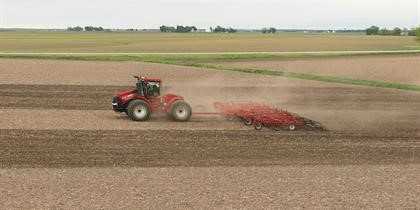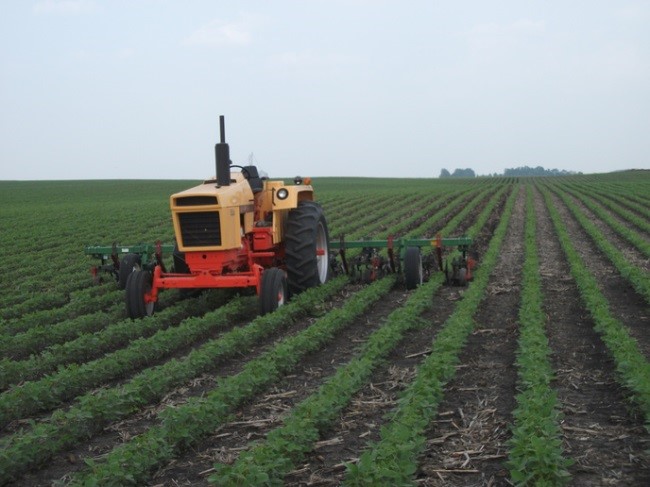Gear Up – Throttle Down – Save Fuel
Selecting the right tractor, setting the right gear, and reducing the throttle to the right RPM’s can save fuel and generate big savings when operating your tractor in field operations.
POWER, ENERGY, EFFICIENCY

Fuel costs can be a significant portion of a farm’s expenses. With tractors and field equipment, we sometimes think that the operation we’re performing must always be done with the tractor running at a high RPM and that lower RPM’s might be bad for the engine and drive components. This is not necessarily true.
The Size of the Tractor chosen for a light drawbar load is a good example. Smaller tractors have greater fuel efficiency; this is well known. When pulling small loads, or operating a relatively lightweight PTO driven machine, a smaller tractor will always be the best choice. However, when draft or resistance from the machine increases, sizing up the tractor can lead to more efficiency.
A good example in “Gear Up and Throttle Down – Saving Fuel”, a Virginia Cooperative Extension Publication, compares a choice between two tractors. The first is a 165 drawbar horsepower tractor and the second is a 314 drawbar horsepower machine. Should you:
- Use the small tractor at full throttle and full load
- Use the large tractor at 50% load
- Use the larger tractor at 50% load but ‘gear up and throttle down’
Even though the smaller tractor has good fuel efficiency (15.5 hp-hr/gal) at full power than the larger tractor at full power (12.94 hp-hr/gal); the larger tractor actually will consume less fuel when operated at 50% power and geared up to the same ground speed as the smaller tractor in this comparison. The result was 10.66 gal/hr for the smaller tractor operating at full power, 12.75 gal/hr for the larger tractor operating at full power, and 9.69 gal/hr for the larger tractor operating at 50% power…you accomplish the same task in the same time (or even faster), and you use less fuel.

For operations that don’t require the tractor to run at full power, such as row crop cultivating, gearing up and throttling down can save a significant amount of fuel.
You can find that most efficient point by observing how much the engine ‘bogs down’ when you are in the field. If you’re seeing a lot of black smoke out of the exhaust, you’re probably in too high a gear…shift down and throttle up…but once operating, gearing up and throttling down can lead to big savings over the course of a day’s field work.
Ballast is a requirement on some tractors to increase the weight of the front, rear, or total axle weight, depending on the operation. Ballast will increase the tractive efficiency of the tractor when pulling heavy draft loads; but it also requires more horsepower, and can increase soil compaction. If ballasts can be removed for different operations, this can be an advantage when pulling loads that don’t require a lot of ballast. Ballast racks on the front of the tractor, or wheel ballasts can be removed when a tractor isn’t going to be expected to pull heavy drafts, and can improve fuel economy while also reducing soil compaction.
Gearing Up and Throttling Down can be a significant contributor to your variable costs on the farm while reducing the use of fuels which is more environmentally beneficial as well. This practice is suitable for light drawbar loads and jobs which won’t require the use of the power take off (PTO) shaft. PTO driven implements are set up to run at rated engine speeds for efficiency and effectiveness of the tool. You should always follow the PTO rated speed as recommended for the implement as it will adversely effect the equipment’s efficiency if not followed.
By: John Deibel, Freelance Contributor to Tractor Export
How do you liked this post? Let us know in Facebook or Google+
Learn more about fuel efficiency by visiting some of these sites:
“Gear Up and Throttle Down – Saving Fuel”, – Virginia Cooperative Extension
Gear Up – Throttle Down – R. Koelsch, Cornell University – Northeast Region Agricultural Engineering Society
Gear Up Throttle Down – Iowa Farmer Today
The Industry Standard for Tractor Testing is the Nebraska Tractor Test Laboratory
The Nebraska Tractor Test Laboratory – website
The University of Nebraska Tractor Test Laboratory (NTTL) is the officially designated tractor testing station for the United States and tests tractors according to the Organization for Economic Co-operation and Development (OECD) codes OECD codes. Tractors are tested in the country of manufacture. Twenty-nine countries adhere to the tractor test codes (including non-OECD members: China, India, the Russian Federation, and Serbia) with active tractor test stations in approximately 25 of those countries. Reciprocity agreements with the codes require that once an OECD test report is officially approved, it must be accepted by all participating countries.



